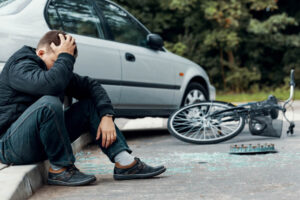After a bicycle accident, you may have many questions about how to proceed with a case against the liable parties.
The following answers some of the most frequently asked questions about accidents to your bicycle accident lawyer.
1. How Often Do Bicycle Accidents Occur?
Bicycle accidents are commonplace across the U.S. According to the Centers for Disease Control and Prevention (CDC), 130,000 bicyclists sustain injuries, and 1,000 bicyclists die every year in accidents. These result in steep costs, with the expenses for bicycle accident injuries and deaths totaling over $23 billion yearly. These costs apply to the medical expenses, estimated costs for lost lives and quality of life, and overall work productivity loss.
2. What Are the Most Common Causes of Bicycle Accidents?
There are many potential causes of bicycle accidents involving motor vehicles. The following are some of the most common causes:
Distracted Driving
Distracted driving is one of the most common causes of vehicle accidents of any type. Drivers often cause accidents when they engage with various distractions on the road. These could include visual, manual, and cognitive distractions. Visual distractions include those that take drivers’ eyes away from the road, including billboards and other elements outside the vehicle, along with phone notifications and other stimuli.
Meanwhile, manual distractions lead drivers to remove their hands from the steering wheel and may include dashboard tasks or engaging with passengers in the vehicle. Cognitive distractions take drivers’ minds away from the road and may consist of distracting thoughts or tasks that take the driver’s mind off the task of driving.
Not Leaving Enough Space Between Vehicles and Cyclists
 Drivers must give cyclists plenty of space to avoid a collision. Specifically, drivers should leave a safe distance of at least three feet between the vehicle and the bicycle. Giving ample space gives drivers time to stop or slow down if bicyclists need to stop or slow down for any reason. This space also gives cyclists plenty of room to avoid getting into an accident if they need to maneuver around vehicles.
Drivers must give cyclists plenty of space to avoid a collision. Specifically, drivers should leave a safe distance of at least three feet between the vehicle and the bicycle. Giving ample space gives drivers time to stop or slow down if bicyclists need to stop or slow down for any reason. This space also gives cyclists plenty of room to avoid getting into an accident if they need to maneuver around vehicles.
Improper Lane Changes
Drivers need to check their blind spots and ensure a lane is clear before making a lane change at any time. Drivers often get into accidents with cyclists when they neglect to check their side-view mirrors and blind spots, believing the lane is clear.
Speeding
Another common cause of bicycle accidents is speeding. The faster a vehicle travels, the less time the driver will have to react to any obstacles in the road and stop or slow as needed. Even accidents at lower speeds can cause severe injuries to cyclists.
Turning Without Looking
Drivers may believe they have the right of way to turn when the light turns green at an intersection, but they should also check for cyclists and pedestrians crossing the road before making a turn. Often, accidents occur when drivers fail to check the intersection before completing their turn.
These and other causes can lead to serious accidents and injuries or fatalities. Other potential causes of bicycle accidents may include failure to yield, driver fatigue, impaired driving, and running red lights and stop signs. Accidents may also result from other external factors, such as poor road conditions and inclement weather.
3. Who Is at Fault When a Bicycle Collides With a Car?
In most cases, drivers are liable for bicycle accidents with cars when they fail to take proper precautions to give bicyclists ample space or notice their presence.
4. What Should I Do After a Bicycle Accident?
After a bicycle accident occurs, you may take certain steps to recover from any injuries sustained and build a potential case against liable parties.
Some of the steps to take after a bike accident include:
Follow Your Doctor’s Orders
Sticking to your treatment plan after seeking treatment for any injuries resulting from an accident is important. Doing so will help you make a full medical recovery and provide you with medical records that may help prove the extent of your injuries in a claim or lawsuit. Let your doctor know if you want to change your treatment plan.
Collect Evidence for Use in a Claim
Whether you file a first-party claim with your own insurer or a third-party liability claim against a liable party’s insurer, you’ll want to collect enough evidence to prove the extent of your injuries and that they resulted from a bicycle accident. In a third-party claim or lawsuit, you will need evidence showing how the other party’s negligence caused the accident.
The evidence you may use in a bicycle accident case to prove injuries and negligence includes:
- Medical documents such as records and bills
- Proof of lost income in the form of pay stubs, W-2s, and other documents
- The police report from law enforcement officials
- Witness statements
- Photos and video evidence of injuries, damages, and the accident scene
- Bills for repairs and replaced personal belongings damaged in the accident
An attorney may help you collect any evidence you’re unable to obtain on your own.
Speak With a Bicycle Accident Lawyer
Before you begin a claim or lawsuit, you should bring all documentation you’ve collected to an attorney with experience handling bicycle accident cases.
An attorney can discuss your case and indicate your compensation options. If the attorney chooses to take on your case, they may help you collect and organize all relevant evidence to build a case. Attorneys can negotiate with insurers and liable parties to seek a fair settlement.
5. What Types of Compensation Can I Recover for a Bicycle Accident?
If you get involved in a bicycle accident and sustain injuries and other types of damages, you may recover different compensation in a bicycle accident case.
There are a few main types of compensation you may recover, including:
Economic Damages
The first damage to consider is economic or special. Economic damages are damages that account for all financial losses sustained because of an accident. These losses include medical expenses for diagnosing and treating injuries, lost income, lost earning capacity, the cost of bicycle repairs or replacements, and any other costs associated with the accident.
Non-Economic Damages
In addition, victims may recover non-economic damages, also known as general damages. These damages apply to victims’ pain and suffering following an accident.
For example, victims may recover compensation for their physical pain and mental anguish from an accident. While proving these damages is more difficult than proving economic damages, victims may do so by documenting their experience in a journal.
Punitive Damages
In rare cases, the courts may award punitive damages to victims who suffered losses because of a defendant’s gross negligence or malicious acts. These supplement compensatory economic and non-economic damages deter similar behavior.
Wrongful Death Damages
If a victim dies in a bicycle accident, the victim’s loved ones may file a claim or lawsuit on their behalf to recover wrongful death damages. These damages could include all of the above economic, non-economic, and punitive damages, along with others pertaining to the person’s death.
For instance, a victim’s family may sue to recover compensation for funeral and burial expenses and the loss of services that the individual provided for the family.
6. What Injuries Can Result From a Bicycle Accident?
Many injuries may result from bicycle accidents, such as:
- Head injuries – These injuries occur in around 22 percent to 47 percent of all injuries.
- Traumatic brain injuries (TBIs) – These may range from less severe injuries such as concussions to more extensive brain damage.
- Abrasions – These injuries involve scrapes and brush burns that cause damage to the skin.
- Lacerations – Bicyclists may sustain lacerations involving deep tears or skin cuts.
- Fractures and broken bones – Bicyclists can easily experience bone breaks and fractures from the force of impact in accidents.
Other bicycle accident injuries may include strains and sprains, spinal cord injuries, and joint dislocations.
7. How Long Do I Have to File a Bicycle Accident Claim or Lawsuit?
Following a bicycle accident, you have limited time to initiate an insurance claim or a lawsuit.
The first limit to consider is your insurer’s time limit to report your accident. You typically have around 30 days to notify insurers of an accident, but you should check your policy to determine exactly how much time you have. Insurers will also give you a limited time to file a claim if you want to recover compensation.
Another time limit to consider is your state’s statute of limitations for vehicle accidents. If you don’t file a claim or lawsuit before the statute of limitations expires, you cannot recover compensation from liable parties. The statute of limitations for vehicle accidents in most states is around two to four years after the accident or discovery of the injury.
An attorney can determine the statute of limitations in your state and build a case before it expires.
Even if you believe you have a long time to build a case, file sooner rather than later. The sooner you start on a case, the sooner you can seek compensation and recover reimbursement for losses resulting from the accident.
8. Who Is Responsible if the Driver Who Hit Me Was Working?
If an accident occurs and the driver responsible was working, you may file a claim or suit against the driver’s employer. However, you would need to prove that the driver acted within their scope of employment at the time of the accident.
9. What Happens if a Defective Part Causes a Bike Accident?
In some cases, bicycle accidents may result from defective parts due to faulty designs or manufacturing. If a defective part contributed to a bicycle accident, you may hold the manufacturer liable in a product liability case.
Several potentially defective parts in bicycles can fail and cause accidents, including:
- Carbon forks
- Wheels
- Brakes
- Carbon fiber frames
- Quick-release wheel hubs
In addition to manufacturers, you can hold other parties responsible in product liability cases. For example, you may sue assembly companies, distributors, wholesalers, repair shops, or retailers if they provide you with defective bicycles or individual parts.
Have Additional Questions About Bicycle Accidents?

Andrew Finkelstein Bicycle Accidents Lawyer in New York
These are some of the many questions people may have about bicycle accidents. If you need answers to more questions, you may obtain the information you need by speaking with a personal injury attorney in New York. An attorney can meet with you to discuss a potential claim or lawsuit and answer your questions about how these cases work.
